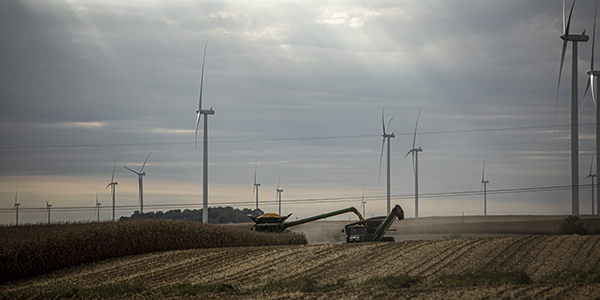AGRONOMICSUPPORT
YOU CAN TAKETO THE FIELD
Challenges of Delayed Corn Harvest
As I talk to Farmers this fall, one common theme comes out of our conversation is: “My corn is wet this year.” So, I want to remind corn growers of some ideas to help with this situation.
When corn reaches maturity late in the season, field dry down is slower due to cooler temperatures. It looks that in western Wisconsin, October has been cooler than normal and November is starting out to be the 4th coldest in history. This means that grain will probably be “wet” when harvested.
First, set combines carefully. You will need to balance the need for aggressive shelling against the kernel damage from the aggressive shelling. Also balance the cleaning chaff and small particles against blowing small light kernels out the back of the combine.
Using proper drying procedures is essential this year to avoid quality reductions during this process. Screen lower quality grain out using a rotary or gravity screen to prevent fines from blocking airflow to the dryer. Proper airflow will help with uniform drying and storage of corn. If grain quality is an issue, dry it a couple points lower than the normal 15%, because there can be variations in moisture within the grain mass and physical appearance. Safe storage should be 15% for winter storage, 14% for storage into spring and summer, and 13% for storage a year or more.
Next you need to think about limiting drying temps. High temperatures at drying causes stress cracks and can cause breakage during handling, especially for grain 25-30% moisture. Drying too fast may also reduce test weight to unacceptable levels. To minimize storage problems, screen corn before putting in the bin. After filling, remove the center approximately 10% of the bin to clean out fines that would accumulate in the middle while filling. Cool grain as soon as possible. Optimum temperatures would be within 10 degrees of air temp. Continue to aerate 10- 14 days to ensure grain moisture “equilibrium” has been achieved. Usually 20 to 30oF for winter storage in the upper Midwest.
Finally, Be Safe out there! Grain harvest can be dangerous during the best of conditions and elevated when handling wet or immature corn. Combine fires can occur due to chaff build up and difficult harvest conditions. Clean combines regularly. Dryer fires are possible due to longer dry times and fines build up. Injuries due to long hours and slow harvest. Health problems from breathing in dusts and spores from moly grain. All things to be aware of for a safe harvest season. Take care.
Sources and additional Information:
https://www.agry.purdue.edu/ext/corn/cafe/harvest/index.html






Technical Team Agronomist